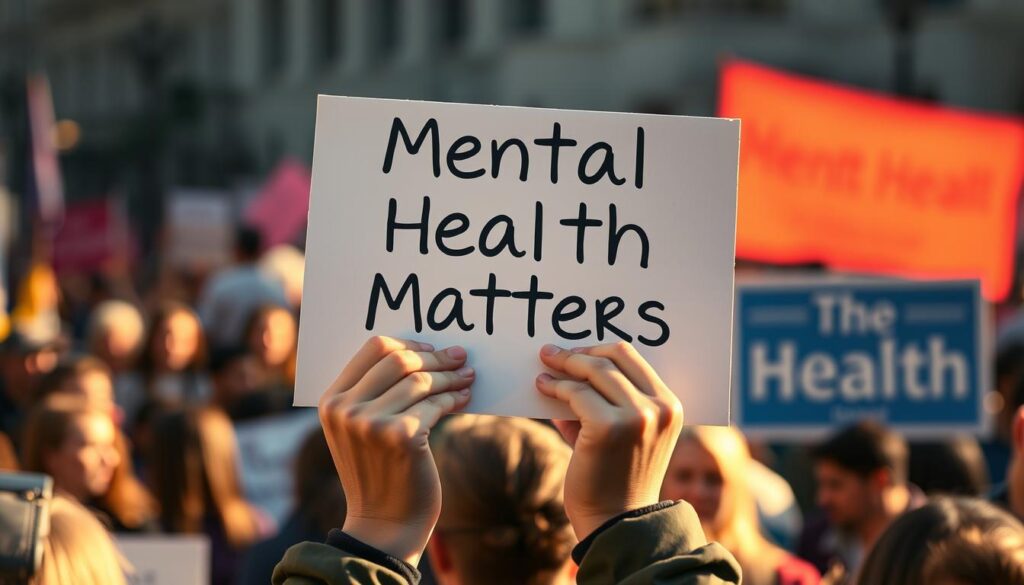Since 1949, Mental Health Awareness Month has been a key effort to help millions of Americans with mental health issues. The National Alliance on Mental Illness (NAMI) has been a big help in spreading awareness and fighting stigma.
We know how important it is to help people take charge of their health. By understanding the value of mental health awareness, we can build a supportive space. This space helps people grow and recover.
Key Takeaways
- Mental Health Awareness Month has been observed since 1949.
- NAMI is a key organization promoting mental health awareness.
- Awareness is crucial in reducing stigma around mental health.
- Empowering individuals is vital for their well-being.
- Creating a supportive environment is essential for growth and recovery.
Understanding Mental Health Fundamentals
Modern life is complex, and knowing about mental health is key. Mental health affects how we think, feel, and act. It’s not just the absence of illness but a state of well-being that helps us deal with life’s stresses.
Defining Mental Health in Modern Context
Mental health covers emotional, psychological, and social well-being. It shapes how we handle stress, interact with others, and make decisions. Today, mental health is seen as vital, just like physical health.
Mental health education is crucial. It helps us understand and reduce stigma. By learning and sharing, we can improve mental health care.
The Spectrum of Mental Well-being
Mental well-being spans from optimal health to illness. Knowing this spectrum helps us spot mental health issues early. It also guides us to seek the right help.
| Mental Health State | Characteristics | Support Strategies |
|---|---|---|
| Optimal Mental Health | High resilience, positive relationships, productive work habits | Maintain healthy habits, practice self-care, build strong social connections |
| Mental Health Challenges | Stress, anxiety, depression, or other mental health issues | Seek professional help, practice stress management, engage in therapy |
| Mental Illness | Significant impairment in daily functioning due to mental health conditions | Access professional treatment, adhere to treatment plans, utilize support networks |
Breaking Down Common Misconceptions
Despite growing awareness, myths about mental health still exist. One myth is that mental illness shows weakness. But, it can affect anyone, no matter their strength.
Another myth is that mental health issues mean no recovery. But, with the right treatment and support, many people can manage their conditions and live well.
By pushing for mental health education and awareness, we can challenge these myths. This helps create a more supportive and understanding community.
Recognizing the Signs of Mental Health Challenges
Mental health challenges show up in many ways. It’s important to know the signs. Conditions like anxiety, depression, and ADHD can be treated better if caught early.
Emotional and Psychological Indicators
Feeling sad, anxious, or irritable for a long time is a sign. Depression makes you lose interest in things you used to love. Anxiety makes you worry too much, affecting your daily life.
Knowing these feelings and getting help is key. The Mayo Clinic says recognizing symptoms is the first step to treatment. Mood changes, like sudden emotional shifts, can point to bipolar disorder.
Physical Manifestations of Mental Distress
Mental health issues can also show up physically. Changes in appetite or sleep can signal mental health problems. Eating disorders, like anorexia, involve unhealthy dieting or bingeing.
It’s important to remember that mental and physical health are connected. Mental health issues can cause physical symptoms like headaches. Getting help can address both the mind and body.
Behavioral Changes to Watch For
Changes in behavior can also be a sign. Pulling away from friends, doing poorly at work or school, or taking risks are red flags. ADHD can cause inattention or hyperactivity, impacting daily life.
“Early intervention is key to managing mental health conditions effectively. By recognizing the signs and seeking help, individuals can improve their quality of life.”
Knowing the signs of mental health challenges helps us support ourselves and others. Using mental health resources and getting professional help is crucial for good mental health.
Mental Health Awareness: Why It Matters
Modern life is complex, making mental health awareness crucial. The path to mental wellness involves personal effort, community support, and systemic changes.
Mental health awareness is key because it shapes how we tackle mental health challenges. It helps build a culture of understanding and support. This way, people feel free to seek help without fear.
Reducing Stigma Through Education
Education is a strong tool against mental health stigma. By teaching mental health in schools and community programs, we clear up myths. This makes the public more informed and empathetic.
NAMI’s “In Every Story, There’s Strength” theme shows the power of sharing experiences. Personal stories of struggle and recovery humanize mental health. They encourage others to share their stories too.
Creating Supportive Communities
Supportive communities are vital for mental health. They make it safe to talk about mental health, leading to early help and prevention. Online and offline groups offer a space to share and get support.
To build supportive communities, we must:
- Promote mental health awareness through local events and campaigns
- Encourage open conversations about mental health
- Provide resources and support for those affected by mental health issues
Improving Access to Care
It’s essential to improve mental health care access. This means more services and making them affordable and accessible.
| Strategy | Description | Impact |
|---|---|---|
| Expanding Insurance Coverage | Increasing insurance coverage for mental health services | More individuals can access necessary care |
| Telehealth Services | Utilizing telehealth for remote mental health support | Increased accessibility for rural and underserved populations |
| Community Clinics | Establishing clinics in community settings | Reduced barriers to accessing care |
By focusing on these areas, we can greatly improve mental health support. This creates a more compassionate and understanding society.
How to Conduct a Personal Mental Health Assessment
A personal mental health assessment is a powerful tool. It lets you check your mental state and make smart choices about your care. By knowing your mental health, you can spot areas to improve and work towards a better life.
Implementing Daily Mental Health Check-ins
Daily mental health check-ins are key to keeping an eye on your emotional and mental health. These check-ins mean taking a few minutes each day to think about your feelings and thoughts. This helps you understand your mental state and notice any changes or worries.
To make daily check-ins work, pick a time each day, like in the morning or before bed. You can write in a journal or use apps for tracking your mental health.
Tools for Tracking Mood and Energy Patterns
Tracking your mood and energy can give you important insights into your mental health. There are many tools and methods to help you keep an eye on these patterns. These include mood journals, apps, and wearable devices.
- Mood journals help you track your emotions and thoughts, showing patterns and triggers.
- Mobile apps offer a simple way to monitor your mental state and get support.
- Wearable devices track physical signs, like heart rate and sleep, which can show mental health.
Recognizing When to Seek Professional Help
Knowing when to get professional help is crucial for good mental health. If you see lasting changes in your mood, energy, or overall health, it’s time to talk to a mental health expert.
Mental health initiatives, like Mental Health First Aid, teach you to spot mental health issues and when to get help. They stress the value of learning and support for good mental health.
Building Your Mental Health Support Network
A strong support system is key to good mental health. Having people you trust makes a big difference in your journey.
To build a good support network, find people who offer emotional, practical, and professional help. They can help you through tough times and celebrate your wins.
Steps to Identify Key Support Figures
Finding the right people for your support network means looking at your current relationships and maybe expanding your circle.
- Start by listing people you see often, like family, friends, and coworkers.
- Think about who can give you emotional support, practical help, or professional advice.
- Let them know you value their support and are there for them too.
Methods for Setting Boundaries with Toxic Relationships
Not all relationships are good for your mental health. It’s important to spot toxic ones and set boundaries.
Setting boundaries means:
- Spotting behaviors that drain you or cause stress.
- Telling the other person what you’re comfortable with and what you’re not.
- Being firm and consistent in keeping your boundaries, even if it means stepping back.
Strategies for Expanding Your Circle of Support
Expanding your support network can mean joining groups or communities that share your interests or struggles.
Some ways to do this include:
- Finding local or online groups focused on mental health or your specific issues.
- Getting involved in local events, volunteering, or hobbies to meet others.
- Using social media and online forums for mental health support.
Building a mental health support network takes time and effort. By finding key supporters, setting boundaries, and growing your network, you can create a strong support system that boosts your mental well-being.
Implementing Effective Self-Care Practices
To improve our mental health, we need to take care of our body, mind, and emotions. By doing self-care every day, we can live better and handle stress better.
Incorporating Physical Activity for Mental Well-being
Being active is key for our mental health. Exercise can lower anxiety and depression, make us feel happier, and help our brain work better. We can start by doing fun activities like walking, jogging, or swimming every day.
Tips for incorporating physical activity:
- Schedule physical activity at the same time each day to make it a habit.
- Find a workout buddy or join a fitness group to stay motivated.
- Mix up your routine to avoid boredom and prevent plateaus.

Optimizing Nutrition for Mood and Mind
Eating well is important for our mental health. Eating foods that are good for our brain helps us stay well. We should eat lots of fruits, veggies, whole grains, lean proteins, and healthy fats.
Nutritional tips for mental health:
- Stay hydrated by drinking plenty of water throughout the day.
- Limit intake of processed and sugary foods.
- Incorporate foods rich in omega-3 fatty acids, such as salmon and walnuts.
Establishing Healthy Sleep Hygiene Routines
Good sleep is crucial for our mental health. Bad sleep habits can cause anxiety and depression. By sleeping the same hours every night and making our bedroom a sleep place, we can sleep better.
Practicing Mindfulness and Meditation Techniques
Mindfulness and meditation are great for our mental health. They can lower stress, help us feel better emotionally, and make our brain work better. We can start with short mindfulness exercises like deep breathing or body scan meditation.
Mindfulness tips:
- Start with short sessions (5-10 minutes) and gradually increase duration.
- Use guided meditation apps or videos to get started.
- Practice mindfulness in daily activities, such as eating or walking.
Accessing Mental Health Resources in America
The mental health resources in America are varied. This includes insurance and digital tools. It’s important to know about these resources for mental health support.
Navigating Insurance Coverage Options
Finding mental health insurance can be tricky. Many plans cover these services, but how much varies. Knowing our insurance helps us get the care we need.
Here are key points to consider when navigating insurance coverage:
- Check if your insurance plan covers mental health services.
- Understand the copayment and deductible for mental health services.
- Find out if your insurance requires a referral from a primary care physician.
- Know the network of mental health providers covered by your insurance.
Finding Free and Low-Cost Mental Health Services
Not everyone has insurance for mental health. But, there are affordable options. Community centers, non-profits, and online resources offer help.
| Resource | Description | Cost |
|---|---|---|
| Community Mental Health Centers | Provide comprehensive mental health services | Low-cost or free |
| Non-profit Organizations | Offer counseling and support groups | Free or low-cost |
| Online Resources | Provide mental health information and support | Free |
Evaluating Digital Mental Health Tools and Apps
Digital tools for mental health are getting popular. They offer easy access to resources like therapy and mood tracking.
When evaluating digital mental health tools, consider the following:
- Look for apps and tools that are evidence-based.
- Check user reviews and ratings.
- Understand the privacy and security measures in place.
- Consider the cost and whether it is covered by your insurance.
By understanding and using these resources, we can support our mental health and communities better.
Supporting Someone with Mental Health Challenges
Understanding and empathy are key when supporting someone with mental health issues. It’s important to be sensitive and well-informed.
Mastering Supportive Communication Techniques
Good support starts with listening well. We must validate the feelings of the person we’re helping, without judging. This makes them feel safe to share their feelings and worries.
Using open-ended questions helps them open up. And avoiding unsolicited advice shows we respect their choices. For more tips, check out Mental Health UK.
Offering Practical Assistance Without Overstepping
Helping out can mean doing chores or going to appointments with them. It’s key to find a balance between helping and respecting their freedom.
- Identify specific tasks you can help with.
- Be clear about your capabilities and limitations.
- Respect their decisions regarding their care.
Maintaining Your Own Well-being as a Supporter
Helping someone with mental health issues can be tough. We must look after ourselves to avoid getting burned out. This means getting support from friends, family, or mental health resources.
Responding Effectively to Mental Health Crises
In a crisis, staying calm and acting fast is crucial. Knowing the signs and having a plan can help a lot. We should know about mental health support hotlines and emergency services in our area.
Being informed and ready helps us support our loved ones in tough times. This ensures their safety and well-being.
Engaging in Mental Health Advocacy
By getting involved in mental health advocacy, we can help people get the help they need. It’s key to raise awareness, support those facing mental health issues, and push for change in our communities. Groups like the National Alliance on Mental Illness (NAMI) show how advocacy can make a big difference.

Participating in National Awareness Events
National awareness events are crucial for mental health advocacy. They help educate people and reduce stigma around mental health. For example, Mental Health Awareness Month in May is a time for us to come together and support each other.
We can join events, share info on social media, and take part in local activities. This helps spread the word and builds a supportive community.
Developing Social Media Advocacy Strategies
Social media is a powerful tool for mental health advocacy. It lets us reach many people and gather support fast. To make a strong impact, we should create engaging content, use the right hashtags, and share personal stories of overcoming challenges.
This way, we build a supportive online space. It encourages open conversations and promotes mental health awareness.
Creating Community Engagement Opportunities
Community engagement is at the core of mental health advocacy. By organizing or joining local events, workshops, and support groups, we build a sense of community. It’s vital to make these opportunities accessible and beneficial for everyone.
Through these efforts, we support those facing mental health challenges and help change our culture. Remember, together we can create a more supportive and inclusive society.
Promoting Mental Health in the Workplace
Making the workplace mentally healthy is crucial for business success. It’s vital to support employees’ mental health in today’s work world. This support greatly improves the overall well-being of the organization.
Advocating for Comprehensive Mental Health Benefits
Supporting mental health at work starts with comprehensive mental health benefits. This means giving employees access to mental health services and stress management programs. It shows employers care about their mental well-being.
- Review current mental health benefits to see how to improve them.
- Work with mental health experts to offer on-site or online support.
- Make sure employees know about the mental health resources available.
To learn more about improving mental health benefits, check out https://putrialvi.web.id/offerings/.
Contributing to Psychologically Safe Work Environments
A psychologically safe work environment is key for mental health. It’s about creating a space where talking about mental health is okay. Employees should feel safe and supported.
- Start training to teach the value of mental health and how to support each other.
- Make sure everyone can talk openly about mental health through regular meetings and anonymous feedback.
- Leaders should show they care by being open about their own mental health and setting a good example.
Implementing Work-Life Balance Strategies
Having a good work-life balance is vital for mental health. Employers can help by offering flexible work options and encouraging breaks.
- Give employees flexible schedules, like working from home or flexible hours, to manage work and life better.
- Don’t push for too much overtime and encourage using paid vacation time.
- Provide tools and support for dealing with work stress, like mindfulness programs or employee assistance programs.
Fostering Mental Health Education in Communities
Teaching communities about mental health is key to better well-being. By improving mental health knowledge, we can lower stigma, encourage early help, and create a supportive space for those with mental health issues.
Age-Appropriate Discussions
Talking about mental health with kids is very important. We need to be honest and clear, using words they can understand. This helps them develop emotional smarts and strength.
For younger kids, we can use simple stories to explain feelings. As they get older, we can talk more about mental health problems and how to deal with them.
Community Workshops
Hosting mental health workshops in the community is a great way to reach more people. These can cover topics like managing stress, reducing anxiety, and understanding mental health issues.
To succeed, we should have mental health experts lead the talks. We should also offer resources for more learning and make sure everyone feels safe to ask questions and share thoughts.
Intergenerational Conversations
Starting conversations between different ages can bring people together. Sharing stories and listening helps us understand mental health at all stages of life.
These talks can happen in community centers, schools, or online. This way, everyone can join in and learn from each other.
| Strategy | Description | Benefits |
|---|---|---|
| Age-Appropriate Discussions | Tailoring mental health conversations to the child’s age | Enhances emotional intelligence, builds resilience |
| Community Workshops | Organizing educational sessions led by professionals | Educates the community, reduces stigma |
| Intergenerational Conversations | Facilitating dialogue between different age groups | Fosters understanding, builds community support |
Conclusion: Embracing Ongoing Mental Health Awareness
As we move forward, it’s clear that ongoing mental health awareness is key. It helps us support those with mental health issues. By learning about mental health, spotting signs of trouble, and building support networks, we can create a culture that values mental health.
Our work to raise awareness, support those affected, and push for education is vital. It helps build a society that values mental well-being. We must keep advocating, promoting mental health at work, and educating our communities. This ensures mental health support is available to everyone.
Together, we can make a big difference in the lives of many. Our ongoing commitment to mental health awareness will help individuals and communities across the United States.


